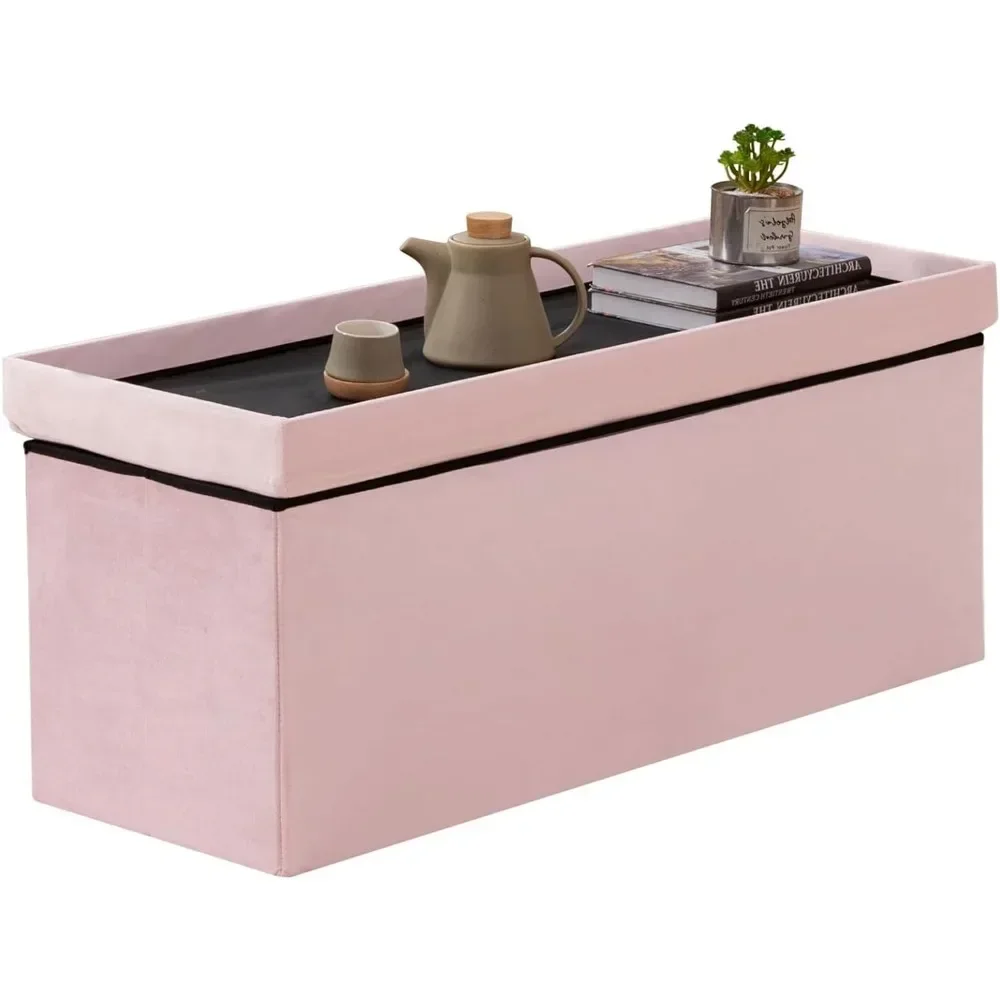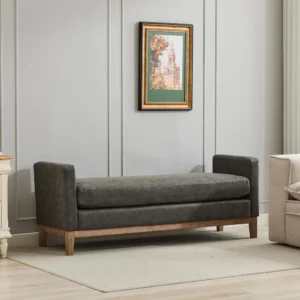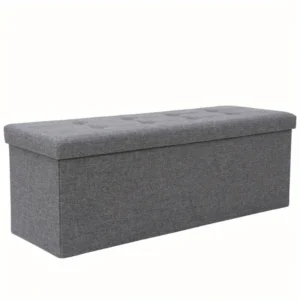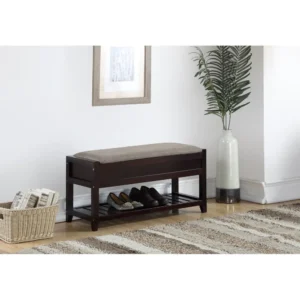The Small Apartment Challenge: Why Benches Are Your Secret Weapon
Living in a small apartment comes with unique challenges that many urban dwellers face daily. Limited square footage means every inch counts, while storage constraints force you to get creative with where you put your belongings. Add to that the need for furniture to serve multiple purposes, and you’ve got quite the organizational puzzle.
This is where benches come in as the unsung heroes of small space living. These versatile pieces solve multiple problems at once:
- They provide essential seating
- They create hidden storage opportunities
- They fit into awkward spaces other furniture can’t
- They serve as functional room dividers or accent pieces
With urban housing sizes shrinking (the average new apartment is now 941 square feet, down 5% from a decade ago) and nearly 30% of apartment renters living in spaces under 800 square feet, making smart furniture choices has never been more important.
Finding effective storage solutions isn’t just about practicality—it’s about mental wellbeing. When your living space is organized, your mind feels clearer too. The right compact storage benches for small apartments can transform both your physical space and your peace of mind.
Throughout this article, we’ll explore how benches can revolutionize your small apartment organization, from selection strategies to room-by-room applications and creative organization techniques that maximize every cubic inch.
Multifunctional Magic: The Benefits of Benches in Small Apartments
Space Efficiency
Benches excel at using space in two directions simultaneously. While most furniture takes up floor space for a single purpose, benches occupy a footprint that serves multiple functions. They make use of both horizontal surface area and vertical volume—something that’s critical when every square foot matters.
Hidden Storage Solutions
The beauty of storage benches lies in their ability to conceal chaos. Open shelving may display your belongings for all to see, but bench storage keeps items out of sight while maintaining a clean aesthetic. This invisible organization system helps maintain the illusion of spaciousness that small apartments desperately need.
Seating + Organization
Unlike standalone storage containers or basic chairs, benches pull double-duty. A typical 48-inch entryway bench provides seating for two adults while simultaneously storing 6-8 pairs of shoes underneath. This dual functionality eliminates the need for separate furniture pieces, freeing up valuable floor space.
Adaptable Design
As your needs change, benches can move and adapt. The same bench that serves your entryway today might become extra dining seating tomorrow or bedroom storage next year. This flexibility is particularly valuable in rental situations where permanent storage solutions aren’t an option.
Visual Space Enhancement
Strategic bench placement can actually make rooms appear larger. Low-profile benches create horizontal lines that extend the visual space, while providing storage that keeps floors and surfaces clear. Exploring different apartment-friendly storage bench ideas can help you identify the perfect solution for your specific spatial challenges.
Selecting the Perfect Storage Bench for Limited Space
Finding the right bench for your small apartment requires careful consideration of several factors:
Space Assessment
Begin by measuring the exact dimensions of your intended placement area. Don’t just measure width—account for depth and height as well. Consider traffic flow around the bench (you’ll need at least 24-30 inches for comfortable passage) and how the bench will interact with nearby furniture.
Storage Needs Analysis
Before purchasing, inventory what you plan to store:
– Bulky items require deeper storage compartments
– Numerous small items benefit from compartmentalized storage
– Heavy items demand sturdier construction
– Frequently accessed items need easy-open mechanisms
Key Dimensions to Consider
- Height: 16-20 inches is standard seating height
- Width: Measure your available wall space minus 4-6 inches for visual breathing room
- Depth: 15-18 inches provides adequate seating without protruding too far into the room
- Storage capacity: Calculate cubic inches based on internal dimensions
Weight Capacity
A bench that serves as both storage and seating needs to support substantial weight. Look for benches rated for at least 250-300 pounds if multiple people will sit simultaneously.
Materials & Construction
For high-traffic areas like entryways, durability is paramount. Solid wood, metal frames, and quality hinges will endure daily use. Fabric benches work well in bedrooms or less frequented spaces.
Style Compatibility
Your bench should complement your existing décor. In small spaces, visual consistency creates harmony that makes the area feel larger. The small entryway bench collection offers options that combine practicality with various design aesthetics.
Types of Storage Benches Ideal for Small Apartments
Entryway Benches
Perfect for creating an organized landing zone, entryway benches typically feature:
– Shoe storage compartments or shelves
– Hooks for coats and bags (either attached or wall-mounted above)
– Small surfaces for mail and keys
– Dimensions tailored for narrow hallways (30-48 inches wide, 12-16 inches deep)
Ottoman Storage Benches
These versatile pieces work wonderfully in living rooms and bedrooms:
– Lift-top designs for easy access to larger items
– Padded tops for comfortable seating
– Typically 16-20 inches high and 30-40 inches wide
– Storage capacity of approximately 3-4 cubic feet
Window Seat Storage
Transform underutilized window areas into functional storage:
– Custom-fit to window dimensions
– Shallow depths (12-15 inches) that don’t protrude into the room
– Perfect for storing seasonal items, books, or blankets
– Creates a cozy reading nook while adding storage
Dining Benches with Storage
Replace traditional dining chairs to save space:
– Typically accommodate 2-3 people in the space of 2 chairs
– Storage capacity for table linens, servingware, or rarely used kitchen items
– Usually 42-60 inches wide and 14-16 inches deep
– Height matched to standard table heights (18-20 inches)
Low-Profile and Slimline Options
For extremely tight spaces, consider:
– Depth as narrow as 10-12 inches
– Height under 16 inches to minimize visual impact
– Length customized to your available wall space
– Simplified storage (single compartment or open shelf below)
Foldable/Collapsible Designs
Maximum flexibility for changing needs:
– Collapse when not in use to free up floor space
– Typically lighter weight for easy movement
– Storage capacity of 1-2 cubic feet when expanded
– Usually 30-36 inches wide when assembled
The narrow entryway bench options are particularly well-suited for the tightest spaces, offering functionality without overwhelming your limited square footage.
Entryway Organization: Creating a Functional First Impression
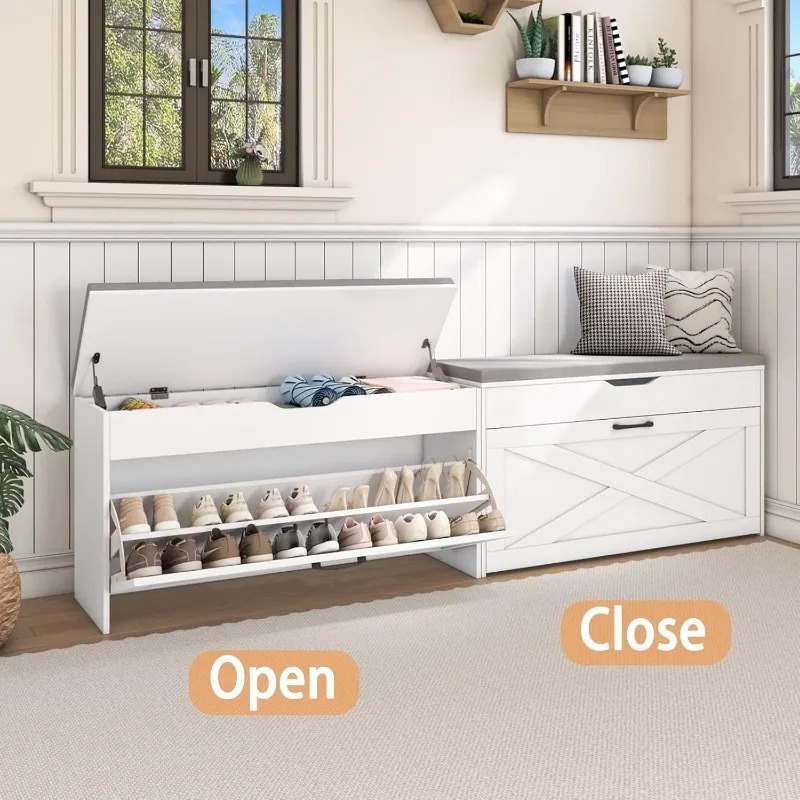
Your entryway sets the tone for your entire apartment, and a well-organized bench system can transform this high-traffic area from chaotic to composed.
Shoe Storage Solutions
Maximize your bench’s shoe capacity with these techniques:
– Arrange pairs with one shoe facing forward, one backward to save depth
– Use the vertical space with shoe racks that stack
– Implement a “seasonal rotation” system, keeping only current weather footwear accessible
– Reserve prime space for frequently worn shoes
Weather Gear Organization
Manage seasonal items efficiently:
– Install hooks above or beside your bench for umbrellas and coats
– Store off-season items in the deepest part of the bench storage
– Use compression bags for bulky winter items during summer months
– Create a small “weather station” with a tray for wet items
Daily Essentials Zone
Keep must-grab items organized and accessible:
– Designate a small dish or tray on the bench surface for keys and wallet
– Add a small mail sorter for incoming and outgoing correspondence
– Create a charging station for phones and devices
– Establish a “leaving home” checklist nearby
Vertical Integration
Don’t forget the wall space above and around your bench:
– Install floating shelves for items that need visibility
– Add hooks at different heights for various family members
– Consider a small mirror for last looks before heading out
– Mount slender cabinets above benches for additional closed storage
The right shoe bench for your entryway combines these elements into one cohesive organization system, making coming and going a smoother experience.
Living Room Bench Strategies: Beyond Basic Storage
In the living room, benches can revolutionize both your storage capacity and your furniture arrangement.
Coffee Table Alternative
Replace traditional coffee tables with storage benches to gain:
– Hidden storage for remote controls, gaming equipment, and magazines
– A soft surface that’s safer for homes with young children
– Extra seating when entertaining guests
– A potential footrest that traditional coffee tables can’t provide
Media Storage Solutions
Keep entertainment essentials organized:
– Divide internal bench storage with small containers for various remotes
– Create dedicated spaces for gaming controllers and accessories
– Store extra charging cables and batteries neatly out of sight
– Organize streaming device components and instruction manuals
Guest-Ready Storage
Be prepared for visitors with hidden supplies:
– Store extra throw blankets and pillows for guest comfort
– Keep folding trays accessible for impromptu snacks and drinks
– Stash board games and cards for entertainment options
– Maintain a small stock of guest essentials like slippers or travel items
Flexible Seating Arrangements
Position benches strategically for maximum versatility:
– Use as supplementary seating that can be moved as needed
– Place perpendicular to sofas to create conversation corners
– Position along walls when not in use to open floor space
– Consider two smaller benches instead of one large for flexible arrangements
Optimizing small entryways with perfect benches follows many of the same principles that make living room bench organization effective—creating multi-purpose spaces that serve daily needs while maintaining visual appeal.
Bedroom Bench Organization: Creating Calm in Your Sanctuary
The bedroom benefits tremendously from the additional organization a bench provides.
End-of-Bed Placement
This traditional spot maximizes otherwise unused space:
– Select a bench approximately 12-18 inches narrower than your bed width
– Use for morning routines like putting on shoes or laying out clothes
– Create a buffer zone between the bed and the rest of the room
– Add a touch of hotel-like luxury to basic bedrooms
Seasonal Clothing Storage
Manage your wardrobe with strategic rotation:
– Store off-season clothes in vacuum bags within the bench
– Organize accessories like scarves, hats, and gloves by season
– Keep special occasion items accessible but out of your daily closet space
– Implement a twice-yearly rotation system to keep your closet current
Bedding Organization
Manage extra linens efficiently:
– Store one extra set of sheets per bed
– Keep special cold-weather bedding accessible but hidden
– Organize by size with simple dividers or fabric bins
– Store guest bedding separate from everyday use items
Footwear Solutions
Control shoe clutter in the bedroom:
– Arrange frequently worn shoes for easy visibility
– Use shoe organizers designed to maximize vertical space
– Implement a “one-in, one-out” policy for bedroom shoe storage
– Store special occasion footwear in protective bags
Entryway benches with storage features can be repurposed beautifully in bedrooms, applying the same organizational principles to create calm, clutter-free personal spaces.
Small Dining Areas: Storage Benches for Double-Duty Dining
Dining areas in small apartments often need to work especially hard, and benches can help maximize both seating and storage.
Dining Bench Configurations
Adapt to your specific table and space:
– Replace chairs on one side of rectangular tables to save 8-12 inches of clearance space
– Use L-shaped bench arrangements in corners to maximize seating
– Consider a complete bench surround with just one or two chairs for maximum capacity
– Select heights that allow comfortable dining (typically 18-20 inches)
Tablecloth, Placemat & Napkin Storage
Keep table linens organized and accessible:
– Roll napkins instead of folding to prevent creases
– Store placemats flat in wide, shallow compartments
– Use acid-free tissue between stored tablecloths
– Implement a simple categorization system by season or occasion
Special Occasion Items
Reserve space for items used less frequently:
– Store special serving pieces, cake stands, and platters
– Keep holiday-specific tableware accessible but out of prime kitchen space
– Organize serving utensils in roll-up fabric cases
– Protect delicate items with simple dividers or soft cloths
The principles used to organize small entryways with benches transfer seamlessly to dining areas, helping you maintain order in this vital living space.
Inside the Box: Maximizing Internal Bench Storage
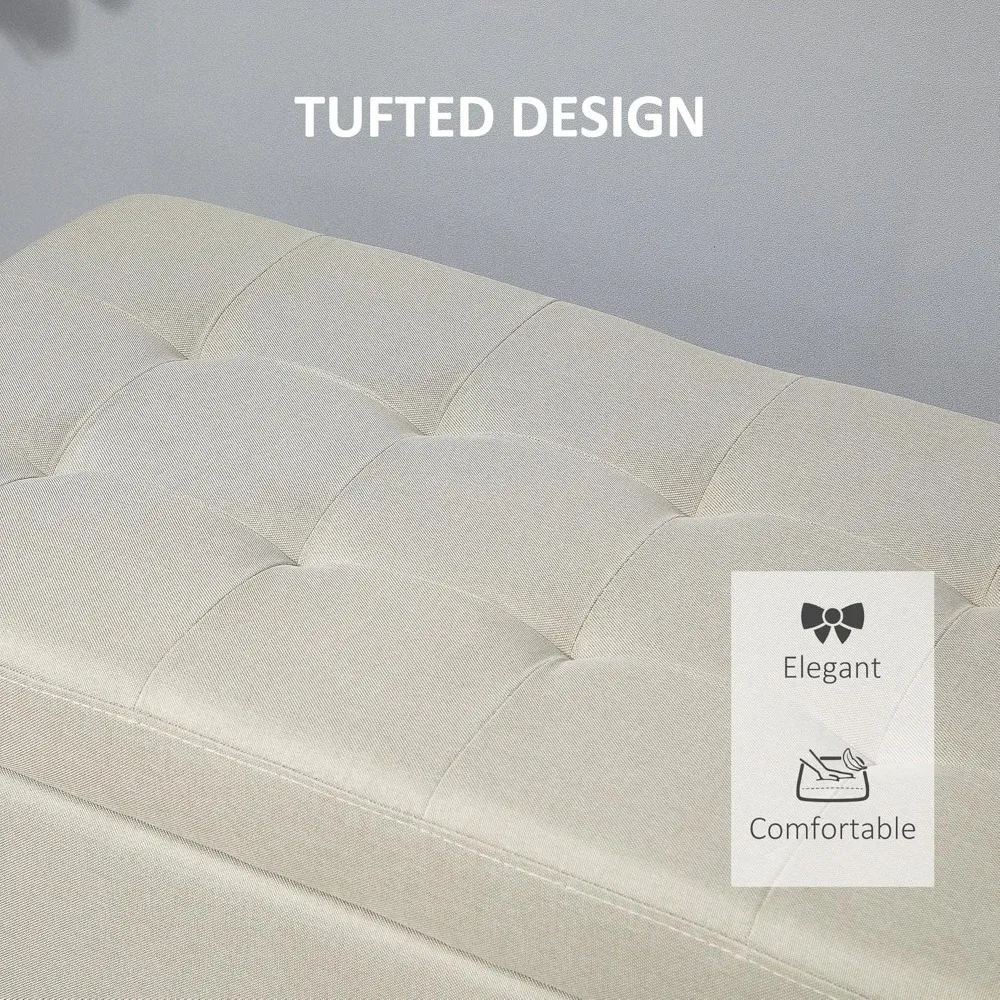
The space inside your storage bench is valuable real estate that deserves thoughtful organization.
Compartmentalization Strategies
Divide and conquer internal space:
– Use adjustable drawer dividers for smaller items
– Implement fabric bins or baskets that fit the internal dimensions
– Create DIY dividers with sturdy cardboard covered in contact paper
– Consider stackable containers that maximize vertical space
Vertical Stacking Methods
Make the most of bench height:
– Place less frequently used items at the bottom
– Use stackable containers with easy-access lids
– Implement shelf risers for additional levels within taller benches
– Consider vacuum bags for soft items to reduce bulk
Compression Techniques
Maximize capacity with smart storage:
– Use vacuum storage bags for seasonal textiles and clothing
– Roll soft items instead of folding when appropriate
– Employ compression cubes for items like winter sweaters or guest bedding
– Select thin, streamlined containers rather than bulky storage boxes
Categorization Systems
Organize for efficiency:
– Group similar items together
– Label containers clearly, including contents and date stored
– Consider color-coding systems for quick visual identification
– Keep an inventory list for less frequently accessed storage benches
Maximizing space and style in studio apartments often relies heavily on these internal organization techniques, turning minimal storage into functional systems.
Creative Organization Solutions: Beyond Basic Bench Storage
Think beyond conventional uses to maximize your bench’s organizational potential.
Room Divider Applications
Define spaces without walls:
– Position high-backed storage benches to separate living and sleeping areas in studios
– Create natural transitions between functional zones
– Use bench backs as display space for decorative items
– Place benches perpendicular to walls to define separate areas
Workspace Integration
Support work-from-home needs:
– Store laptop and office supplies when not in use
– Create a bench workspace that converts to other uses after hours
– Organize cables and technology accessories in designated compartments
– Implement a quick transition system between work and home life
Plant Display + Storage
Combine greenery with organization:
– Store gardening supplies within benches topped with plants
– Create multi-level displays using benches at different heights
– Store seasonal plant care items, extra pots, and soil
– Organize watering tools and plant maintenance supplies
Hobby Material Organization
Contain creative pursuits:
– Designate specific compartments for different hobby materials
– Create project kits that can be easily retrieved and stored
– Use vertical dividers for items like wrapping paper or crafting sheets
– Implement rotation systems for seasonal hobby activities
Entryway benches with shelf storage provide excellent inspiration for these creative applications, with their combination of open and closed storage solutions.
Budget-Friendly and DIY Bench Organization Solutions
You don’t need to spend a fortune to incorporate bench storage into your small apartment.
Upcycling Projects
Transform existing items:
– Convert old dressers into bench seating with storage by removing top drawers
– Repurpose kitchen cabinets with added cushioned tops
– Transform wooden crates into modular bench storage
– Update thrifted hope chests or blanket boxes with new paint and hardware
Simple Construction Ideas
Build basic benches with minimal tools:
– Create storage cubes with plywood and basic joinery
– Build frame benches with storage compartments underneath
– Construct window benches that use premade cabinets as the base
– Design modular pieces that can expand as skills and budget allow
Low-Cost Customization
Enhance basic benches:
– Add basket storage underneath simple bench seats
– Attach hooks or small shelves to expand functionality
– Use decorative boxes that slide under bench seating
– Install casters on the bottom of storage benches for mobility
Secondhand Shopping Strategies
Find hidden gems on a budget:
– Look for solid construction over perfect appearance
– Check for sturdy hinges and hardware that will last
– Measure carefully before purchasing to ensure proper fit
– Consider pieces that can be easily modified for your needs
Maintaining Your Organized Bench Systems
Creating organization is only half the battle—maintaining it is equally important.
Regular Purging Schedule
Prevent overcrowding with consistent review:
– Implement a quarterly review of bench contents
– Apply the “one-in, one-out” rule for stored items
– Set calendar reminders for seasonal rotation of contents
– Be honest about items you haven’t used in a year or more
Cleaning Procedures
Keep benches fresh and functional:
– Vacuum interior compartments monthly
– Wipe down surfaces weekly, especially in high-traffic areas
– Address spills immediately to prevent staining or damage
– Apply appropriate protective treatments to materials annually
Season-to-Season Transitions
Update contents based on current needs:
– Schedule specific dates for switching seasonal items
– Use the transition time to assess what was actually used
– Clean items thoroughly before storing for next year
– Update your inventory list with each seasonal change
Quick Daily Reset Habits
Maintain organization with minimal effort:
– Spend 5 minutes each evening returning items to their proper places
– Create a “drop zone” for temporary items that need proper storage later
– Teach household members the organization system
– Address small messes before they become overwhelming
Entryway Bench with Cushion, Mudroom Bench with Cushion, Shoe Bench for Entryway
$1,186.63 Select options This product has multiple variants. The options may be chosen on the product pageCoat Rack Shoe Bench, Corner Entryway Bench, Corner Hall Tree, Shoe Bench for Entryway
$313.58 Select options This product has multiple variants. The options may be chosen on the product pageEntryway Bench with Back, Modern Entryway Bench, Shoe Bench for Entryway
Price range: $463.13 through $474.44 Select options This product has multiple variants. The options may be chosen on the product pageEntryway Bench with Shelf Storage, Shoe Bench for Entryway, Shoe Storage Bench
$194.08 Select options This product has multiple variants. The options may be chosen on the product pageCorner Entryway Bench, Entryway Bench with Cushion, Modern Entryway Bench, Shoe Bench for Entryway
$476.34 Select options This product has multiple variants. The options may be chosen on the product pageShoe Bench for Entryway, Shoe Bench for Mudroom, Shoe Rack Bench
$477.04 Select options This product has multiple variants. The options may be chosen on the product page
Can Small Benches Really Transform Your Apartment Organization?
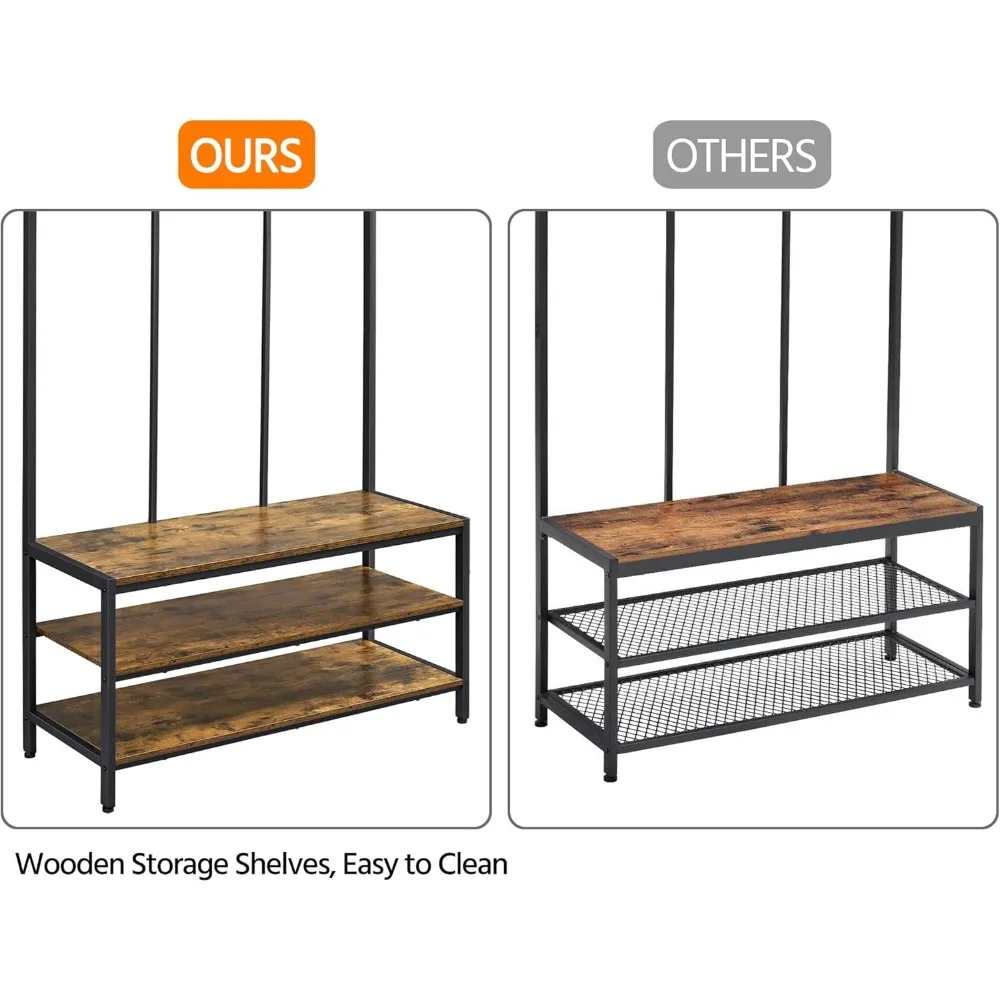
For those skeptical about whether bench storage can make a meaningful difference in truly small spaces, the evidence is compelling.
Q: Can a bench really provide enough storage to matter in a tiny apartment?
A: Even a modest 36-inch bench can provide 3-4 cubic feet of storage—equivalent to approximately 4-5 standard storage bins. That’s enough space to store an entire season’s worth of shoes or all your guest bedding.
Q: Won’t adding furniture make my small space feel even smaller?
A: Unlike bulky single-purpose furniture, benches actually create the illusion of more space by reducing visual clutter and keeping floors clear. A well-placed bench can make a room feel more open by providing hidden storage for items that would otherwise be visible.
Q: How does bench storage compare to other small-space solutions?
A: Unlike vertical shelving that puts everything on display, bench storage conceals items while providing functional seating. Compared to under-bed storage, bench contents are more accessible and don’t require moving furniture to retrieve items.
One studio apartment dweller managed to eliminate three separate storage containers by installing a strategic entryway bench, freeing up nearly 8 square feet of floor space—significant in a 400-square-foot apartment.
What Features Should You Avoid in Small Apartment Storage Benches?
Not all benches are created equal when it comes to small spaces. Here’s what to avoid:
- Oversized dimensions: Benches deeper than 18 inches often protrude too far into limited floor space
- Heavy, unmovable designs: In small spaces, flexibility matters—avoid benches weighing over 50 pounds unless they’re serving a permanent function
- Complex or stiff opening mechanisms: If accessing storage is difficult, you’ll avoid using it
- Low-quality hinges: These fail quickly with regular use and can be dangerous
- Single large compartments without dividers: These quickly become disorganized black holes
- Benches with backs in tight spaces: These can make rooms feel smaller and more crowded
- Bulky decorative elements: Opt for clean lines that don’t visually crowd the space
Instead, look for sleek designs with smart internal features, quality hardware, and proportions scaled appropriately for your specific space constraints.
How Do You Style Storage Benches to Enhance Small Spaces?
The right styling approach ensures your bench contributes aesthetically while maintaining its organizational function:
Balance Function and Beauty
Add decorative elements thoughtfully:
– Limit bench-top decor to 1-3 items that can be easily moved
– Choose accessories that complement your bench’s primary function
– Select items with proper scale—nothing too large or too tiny
– Incorporate both decorative and functional accessories (like a beautiful bowl for keys)
Color and Texture Considerations
Use color psychology to your advantage:
– Light-colored benches visually recede and make spaces feel larger
– Benches that match your wall color create a built-in look that expands the space
– Textured upholstery adds interest without taking up additional space
– Consider contrast only for benches you want to highlight as focal points
Seasonal Refreshes
Update your bench’s look without replacement:
– Swap cushions or cushion covers seasonally
– Change decorative elements monthly for visual interest
– Adjust styling based on functional seasonal needs
– Use removable elements that can be stored when not in use
The most successful small apartment organization solutions blend seamlessly with your decor while providing the function you need daily. With thoughtful selection and creative arrangement, benches can transform your small apartment from cluttered to curated, proving that limited square footage doesn’t have to mean limited style or function.

